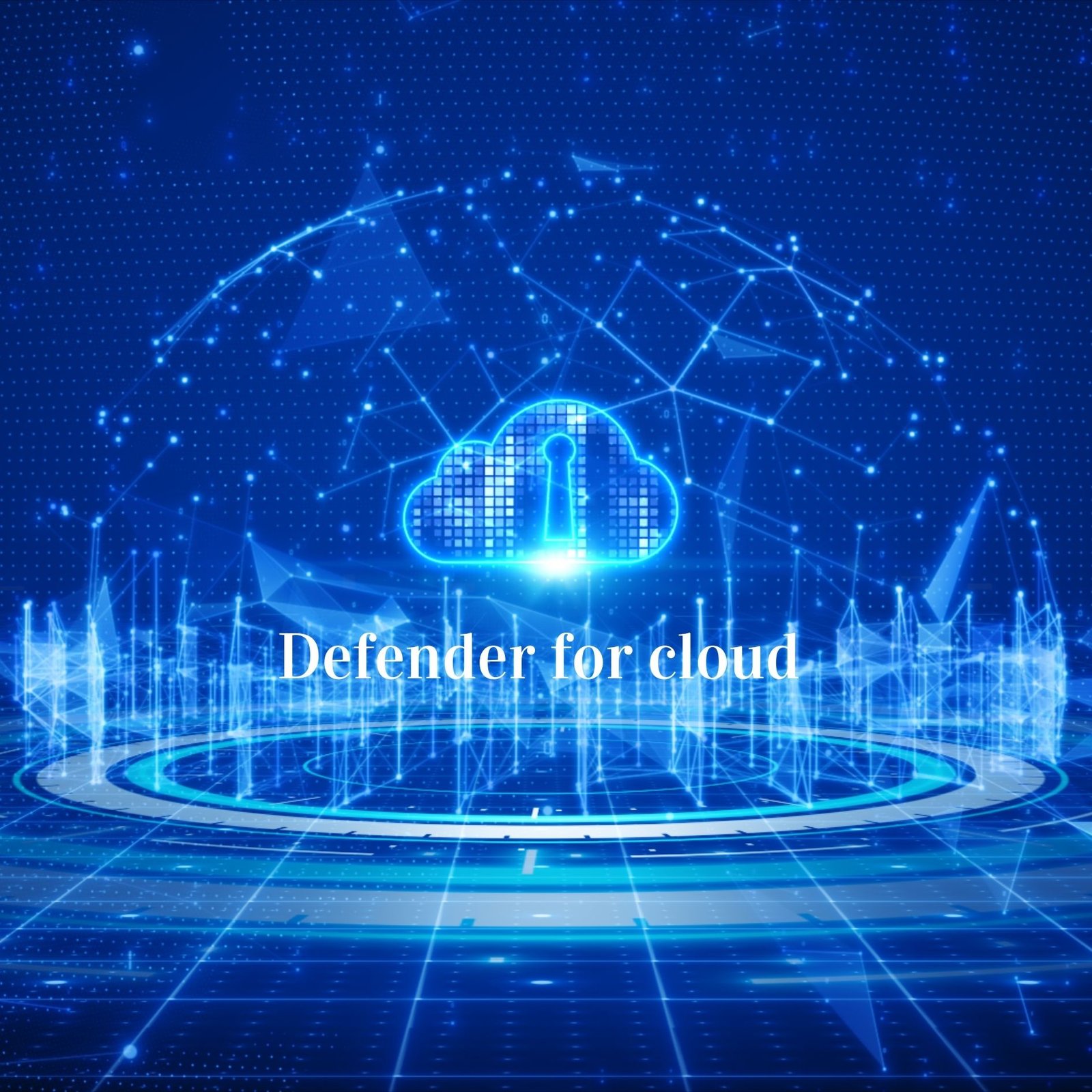Table of Contents
In today’s hyper-connected world, data is the lifeblood of every organization, and securing that data is more critical than ever. As enterprises migrate to the cloud, traditional security models are no longer enough. This is where Microsoft Defender for Cloud steps in — a modern solution built for the dynamic, ever-evolving cloud landscape. Let’s dive deep into the future of cloud security and how Microsoft is leading the charge with its robust security platform.
Introduction to Cloud Security
The Rapid Shift to the Cloud
Over the past decade, we’ve witnessed a massive surge in cloud adoption across nearly every industry. Whether it’s for scalability, cost-effectiveness, or agility, organizations are embracing platforms like Azure, AWS, and Google Cloud to power their operations. But this shift hasn’t come without its challenges. While the cloud opens doors to innovation, it also introduces a broader attack surface for cybercriminals to exploit.
Gone are the days when data lived safely behind a corporate firewall. Today, data moves between on-premises servers, cloud apps, and mobile devices. This interconnected ecosystem demands a new approach to security — one that’s proactive, intelligent, and scalable. Organizations need to rethink how they secure data, applications, and workloads in the cloud, especially as threats become more sophisticated.
Why Cloud Security is Crucial in Today’s Digital Era
Data breaches, ransomware attacks, and advanced persistent threats are not only more common but also more costly. A single misconfiguration in a cloud environment can expose thousands of records to the public internet. And let’s not forget compliance — organizations must navigate a complex web of regulations like GDPR, HIPAA, and CCPA, all while keeping their infrastructure secure.
Cloud security isn’t just a technical challenge; it’s a business imperative. Trust is everything. Customers expect their data to be protected, and regulators demand it. Companies that fail to secure their cloud environments risk not only financial loss but also damage to their reputation and customer trust.
Understanding Microsoft Defender for Cloud
What is Microsoft Defender for Cloud?
Microsoft Defender for Cloud is a comprehensive cloud-native application protection platform (CNAPP). It’s designed to provide security posture management and threat protection across your hybrid and multi-cloud environments. With Defender for Cloud, you get unified visibility into the security of your infrastructure — whether it’s in Azure, AWS, GCP, or on-premises.
At its core, Microsoft Defender for Cloud offers a proactive approach to cloud security. It continuously assesses your environment for vulnerabilities, provides actionable recommendations, and defends against threats in real time. The platform integrates seamlessly with other Microsoft services like Azure Security Center, Microsoft Sentinel, and Microsoft Entra, creating a unified defense ecosystem.
Core Features and Capabilities
Microsoft Defender for Cloud isn’t just about alerting you when something goes wrong — it helps prevent those problems in the first place. Some of its standout features include:
- Security Posture Management: Automatically assesses your environment’s security and offers step-by-step remediation guidance.
- Threat Protection: Detects and responds to real-time threats using behavioral analytics, threat intelligence, and machine learning.
- Compliance Management: Maps your environment to compliance frameworks and helps maintain continuous compliance.
- Integration with DevOps: Scans your code repositories and containers to identify vulnerabilities before deployment.
- Multi-Cloud Support: Secures workloads running on Azure, AWS, and GCP with centralized visibility.
The Evolving Threat Landscape
New-Age Threats and Their Complexity
Today’s cyber threats are more complex and deceptive than ever. Attackers use a mix of social engineering, malware, and advanced evasion techniques to breach even the most fortified systems. Supply chain attacks, insider threats, and ransomware-as-a-service (RaaS) are just a few examples of how the game has changed.
No longer can businesses rely on traditional firewalls or antivirus software. Threats now target misconfigurations, APIs, identity access points, and data transfers within the cloud. And as more organizations adopt DevOps and CI/CD pipelines, the speed of development can sometimes outpace security — making it easier for vulnerabilities to slip through the cracks.
How Cloud Environments Are Vulnerable
Cloud environments offer flexibility and speed, but they’re also inherently complex. With so many moving parts — virtual machines, storage accounts, APIs, containers, microservices — securing every layer becomes a massive challenge. And unlike traditional data centers, cloud assets can be spun up and taken down in minutes, making it hard to maintain consistent security controls.
Misconfigured storage buckets, overly permissive identity policies, and unpatched vulnerabilities are all common pitfalls. Attackers are constantly scanning the cloud for these weaknesses, looking for a way in. Once inside, they move laterally, often undetected, siphoning off data or disrupting operations.
This is why tools like Microsoft Defender for Cloud are essential — they monitor, detect, and respond to these threats before they escalate.
Microsoft Defender for Cloud’s Role in Modern Cybersecurity
Unified Security Management
One of the biggest pain points in cybersecurity is the siloed nature of tools. Many organizations juggle dozens of platforms that don’t talk to each other, leading to blind spots and inefficiencies. Microsoft Defender for Cloud solves this by offering a unified security dashboard that consolidates all your security insights in one place.
This centralized approach enables security teams to quickly identify vulnerabilities, track compliance, and respond to incidents across all environments. You can prioritize alerts based on risk, assign remediation tasks, and monitor progress — all from a single pane of glass.
Threat Detection and Response
Microsoft Defender for Cloud uses cutting-edge threat intelligence from Microsoft’s global security network, which processes over 65 trillion signals daily. With the help of machine learning, Defender can detect anomalous behavior, such as suspicious login attempts, lateral movement within the network, or unusual data exfiltration patterns.
The platform integrates with Microsoft Sentinel and other SIEM tools to automate incident response. Playbooks can be triggered automatically to isolate affected resources, block malicious IPs, or notify the SOC team — reducing the time to respond and contain threats.
Compliance and Regulatory Support
Compliance is non-negotiable in today’s digital world. Microsoft Defender for Cloud helps businesses stay compliant with a range of frameworks like NIST, ISO 27001, CIS Benchmarks, and more. It provides continuous compliance assessments and detailed reports that auditors love.
By mapping security configurations to compliance controls, Defender makes it easier to prove adherence and close gaps before an audit even begins. Whether you’re in healthcare, finance, or government, this feature is a game-changer for managing risk and maintaining trust.
Key Benefits of Using Microsoft Defender for Cloud
Visibility and Control
One of the most significant advantages of Microsoft Defender for Cloud is the level of visibility it offers. In cloud environments, visibility is everything. Without it, you’re essentially flying blind — unaware of vulnerabilities, misconfigurations, or even active threats. Defender for Cloud eliminates this problem by giving you a complete, bird’s-eye view of your entire infrastructure, whether it’s on Azure, AWS, GCP, or hybrid setups.
From a central dashboard, you can monitor workloads, virtual machines, storage accounts, and more. Each asset is continuously assessed against security best practices and compliance frameworks, ensuring you stay ahead of potential risks. The security score system also provides an at-a-glance measure of your environment’s overall health, with clear, actionable recommendations to improve weak areas. This transparency empowers security teams to act quickly and decisively.
Advanced Threat Protection
Threats evolve daily, and yesterday’s solutions won’t protect you from today’s zero-day exploits or insider attacks. Microsoft Defender for Cloud uses AI, behavioral analytics, and Microsoft Threat Intelligence to detect sophisticated threats in real-time. It’s not just about spotting malware — it’s about identifying anomalous behavior that could indicate an ongoing breach.
Integration with Other Microsoft Services
One of Defender for Cloud’s greatest strengths is its seamless integration with the Microsoft ecosystem. If your organization is already using tools like Microsoft 365, Azure Active Directory, Intune, or Sentinel, you’re already halfway to building a robust security infrastructure.
This integration allows for richer context in alerts. For example, an alert in Defender can be correlated with suspicious user activity in Azure AD or a compromised endpoint in Microsoft 365 Defender. This 360-degree view of your security posture is invaluable for incident triage and response.
You also gain the benefit of single sign-on, unified policies, and shared threat intelligence across all Microsoft services. This not only enhances protection but also simplifies administration and reduces overhead.
Security Posture Management with Microsoft Defender
Continuous Security Assessment
Staying secure in the cloud isn’t a one-time setup — it’s an ongoing process. That’s why Microsoft Defender for Cloud focuses heavily on continuous security posture management. It’s always scanning, always learning, and always advising.
As soon as you deploy a resource — whether it’s a virtual machine, Kubernetes cluster, or database — Defender kicks in to assess its configuration. Are ports open to the internet? Are the firewalls misconfigured? Is encryption enabled? These questions are answered in real time, giving you a dynamic and evolving picture of your environment’s risk.
Recommendations and Risk Reduction
Every security team struggles with prioritization. Not every vulnerability poses the same risk, and wasting time on low-impact issues can leave you vulnerable to serious attacks. Microsoft Defender for Cloud helps solve this with contextual risk-based prioritization.
It doesn’t just tell you what’s wrong — it tells you how important it is. For instance, a vulnerability on a publicly accessible VM with sensitive data will be prioritized over a similar issue on an internal test server. This insight helps teams focus their efforts where they matter most.
Automation and AI in Microsoft Defender for Cloud
How AI Enhances Threat Detection
Artificial intelligence isn’t just a buzzword in Microsoft Defender for Cloud — it’s the backbone of its threat detection engine. With access to billions of data points collected from endpoints, user behavior, cloud resources, and threat actors, Defender’s AI models can detect subtle, complex threats that humans might miss.
Let’s say a user logs in from London at 10 AM and then logs in from Moscow five minutes later. AI detects the anomaly. Or perhaps an internal service account is suddenly downloading large amounts of data it never accessed before — that’s flagged too. These kinds of behavioral anomalies are often precursors to breaches, and detecting them early is crucial.
Role of Automation in Incident Response
Time is the enemy during a cyber attack. Every minute that passes increases the potential damage. That’s why automation is critical, and Defender for Cloud embraces it fully.
Through integration with Microsoft Sentinel or Azure Logic Apps, you can create automated workflows for various incident types. For example:
- Automatically isolate a compromised VM.
- Disable suspicious user accounts.
- Send notifications to the SOC team.
- Run a vulnerability scan or patch deployment.
These automations not only reduce response time but also ensure consistent actions — minimizing human error in high-pressure situations. And since they’re customizable, organizations can tailor them to their specific risk tolerance and security policies.
Multi-Cloud and Hybrid Cloud Security
Supporting AWS, GCP, and On-Premises Environments
The modern enterprise doesn’t live in just one cloud. Most companies use a mix of Azure, AWS, Google Cloud, and on-prem infrastructure. Managing security across these environments is complex — unless you have a centralized solution like Microsoft Defender for Cloud.
Defender is uniquely positioned to provide multi-cloud visibility and control. Using built-in connectors, you can onboard AWS and GCP accounts with just a few clicks. From that point on, Defender applies the same level of scrutiny — scanning resources, assessing security posture, detecting threats, and mapping to compliance standards.
Centralized Security Management Across Platforms
One of the greatest challenges in hybrid and multi-cloud environments is fragmentation. Different platforms use different security tools, terminologies, and compliance models. Microsoft Defender for Cloud simplifies this chaos with centralized management.
You can define policies once and apply them everywhere. You can view alerts across clouds in a single dashboard. And most importantly, you can streamline incident response, since all data flows into the same analysis pipeline.
Case Studies and Real-World Applications
Success Stories from Enterprises
Microsoft Defender for Cloud isn’t just theoretical — it’s being used by thousands of enterprises across the globe to secure complex infrastructures and reduce operational risk. From Fortune 500 corporations to fast-growing startups, organizations are leveraging Defender to protect their cloud-native and hybrid environments effectively.
Take for instance a global financial services company that operates in over 100 countries. The company needed visibility across Azure, AWS, and its legacy on-premises infrastructure. After implementing Microsoft Defender for Cloud, they were able to reduce their attack surface by 70% in just six months. Automated threat detection helped their security operations center (SOC) reduce average response times from hours to mere minutes.
These examples highlight the real-world value of Defender — a security solution that scales with your business, no matter the size or complexity.
How Different Industries Leverage Defender for Cloud
Different sectors have unique security challenges, and Defender for Cloud addresses them with precision.
- Finance: Banks and fintechs use Defender to protect sensitive financial data, monitor insider threats, and comply with strict regulatory requirements.
- Healthcare: Hospitals and clinics secure patient records and medical devices, ensuring HIPAA compliance and safeguarding lives.
- Retail: E-commerce platforms rely on Defender to prevent DDoS attacks and secure customer payment information.
- Manufacturing: Industrial organizations use it to monitor OT systems, secure IoT devices, and prevent downtime.
- Government: Public sector agencies benefit from the high-assurance security and compliance features to manage critical infrastructure.
Challenges in Cloud Security Implementation
Common Pitfalls in Configuration
Despite the power of Microsoft Defender for Cloud, its effectiveness heavily depends on how it’s implemented. One of the biggest mistakes organizations make is assuming that merely enabling Defender is enough. In reality, configuration is key.
Some common missteps include:
- Incomplete onboarding: Failing to connect all subscriptions, accounts, and resources means blind spots in visibility.
- Ignoring recommendations: Defender provides detailed security recommendations, but if they’re not actioned, vulnerabilities remain.
- Overly permissive policies: Admins often grant excessive privileges, increasing the risk of insider threats and privilege escalation.
- Alert fatigue: Without proper tuning, the platform can generate too many alerts, overwhelming the SOC team and leading to missed threats.
These pitfalls not only reduce the value of the platform but also leave organizations exposed to risk.
Overcoming Human and Technical Barriers
Cloud security isn’t just a technical problem — it’s a cultural one too. Many organizations struggle with lack of expertise, internal resistance to change, and poor collaboration between security and development teams.
To overcome these challenges:
- Invest in training: Microsoft offers robust certification and learning paths for Defender and Azure security.
- Foster a DevSecOps culture: Encourage collaboration between dev, ops, and security teams to embed security into every stage of the software lifecycle.
- Automate where possible: Use built-in automation to offload repetitive tasks, reduce manual errors, and free up time for strategic work.
- Review policies regularly: Ensure your access controls, compliance rules, and threat detection policies evolve with your business needs.
Future Trends in Cloud Security
Zero Trust Architectures
Zero Trust is no longer just a buzzword — it’s a necessity in the modern security landscape. The core idea? Never trust, always verify. This model assumes that threats can exist both outside and inside your network, so every access request must be authenticated, authorized, and continuously validated.
Microsoft Defender for Cloud supports Zero Trust by integrating deeply with Azure AD, Microsoft Entra, and Conditional Access policies. You can enforce MFA, monitor device compliance, and use context-aware access control to limit exposure.
Microsoft Defender for Cloud Roadmap
Upcoming Features and Innovations
Microsoft continuously evolves Defender for Cloud to meet the ever-changing demands of cybersecurity. Based on recent announcements and insider previews, several exciting innovations are on the horizon:
- Deeper integration with Microsoft Copilot for Security, offering AI-driven security analytics and guided remediation through natural language commands.
- Expanded support for containerized and serverless environments, including better integration with Kubernetes and Azure Functions.
- Enhanced threat intelligence capabilities, enabling predictive threat modeling based on attack patterns seen across the Microsoft ecosystem.
- Policy-as-Code enhancements, allowing security teams to define, version, and deploy policies using code, making governance more scalable.
These features aren’t just upgrades — they’re steps toward a smarter, more automated, and more proactive security platform.
Long-Term Vision and Strategy
Microsoft’s long-term vision with Defender for Cloud is clear: make cloud security intelligent, unified, and automated. It aims to bring together infrastructure, identity, endpoints, data, and applications into a single, cohesive security framework.
This unified platform approach not only simplifies administration but also enables faster response and better visibility. The end goal? Shift from reactive defense to proactive resilience — where threats are stopped before they happen, and businesses can innovate without fear.
How to Get Started with Microsoft Defender for Cloud
Initial Setup and Configuration Tips
Getting started with Microsoft Defender for Cloud is straightforward, but setting it up right from the start makes all the difference.
Here’s a quick roadmap:
- Enable Defender for Cloud in the Azure portal for your subscriptions.
- Connect additional environments like AWS and GCP using built-in connectors.
- Assign security policies and configure regulatory compliance standards.
- Review your Secure Score and implement initial recommendations.
- Enable threat protection plans for workloads like VMs, SQL, containers, and storage.
- Integrate with Microsoft Sentinel or other SIEM/SOAR tools for advanced incident response.
These initial steps ensure that your environment is visible, monitored, and governed from day one.
Best Practices for Deployment
- Start small, scale fast: Pilot Defender on a limited set of resources before rolling out organization-wide.
- Automate compliance: Use the built-in compliance dashboards to monitor standards like CIS, NIST, and HIPAA.
- Use tags and resource groups: Organize your assets logically for better policy application and reporting.
- Customize alerts: Tailor alert thresholds and notifications to avoid noise and improve incident triage.
- Regularly review reports: Make security reviews a routine, not a reaction.
A well-planned deployment ensures long-term success and minimizes risk exposure as your cloud footprint grows.
Comparing Microsoft Defender with Other Cloud Security Tools
Strengths and Weaknesses
Microsoft Defender for Cloud stands tall among the crowd of cloud security tools, but like any product, it has its strengths and areas that could be improved.
Strengths:
- Deep Integration with Microsoft Ecosystem: No other security solution integrates as natively with Azure, Microsoft 365, and Defender for Identity. This synergy allows for richer context, faster response, and a seamless user experience.
- Comprehensive CNAPP Capabilities: Defender for Cloud offers everything from posture management and threat detection to compliance tracking and automation.
- AI and Automation: Defender uses AI models trained on billions of signals, resulting in accurate threat detection and intelligent prioritization.
- Multi-Cloud Support: Defender doesn’t limit you to Azure. It brings visibility and protection to AWS and GCP, making it ideal for hybrid and multi-cloud environments.
Weaknesses:
- Learning Curve: For new users or teams not already familiar with Azure, setting up and fully utilizing Defender can be overwhelming initially.
- Cost Complexity: While it offers flexible pricing, understanding the various plans and SKUs may require careful planning to avoid overspending.
- Dependence on Microsoft Ecosystem: Although it supports multi-cloud, the real power is unlocked when used with other Microsoft products. Organizations using different ecosystems might not get the same level of integration.
Despite these limitations, Defender’s strengths far outweigh its shortcomings, particularly for enterprises already invested in the Microsoft stack.
Conclusion
The future of cloud security lies in intelligent, integrated, and automated solutions — and Microsoft Defender for Cloud is leading the charge. In a world where data breaches are costly and threats evolve by the hour; you need more than just a traditional firewall. You need a platform that understands your environment, adapts to emerging threats, and empowers you to act decisively.
Defender for Cloud brings everything together — visibility, protection, compliance, and automation — under one unified platform. It’s not just about reacting to threats but about proactively managing your security posture and preparing for what’s next.
As we move toward more decentralized, multi-cloud, and DevOps-driven environments, tools like Defender will become essential. It’s not just a layer of defense — it’s the foundation for modern cloud security.









